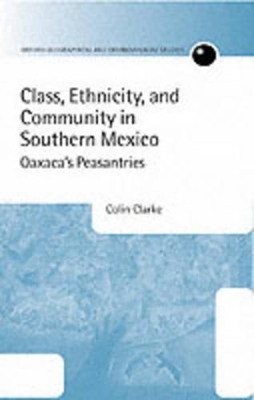Oxford Geographical and Environmental Studies
2 total works
The state of Oaxaca has been studied intensively by archaeologists, historians, and anthropologists, but this is the first comprehensive overview of rural communities in the twentieth century. The study is rooted in the colonial and post-independence periods; but the text concentrates primarily on the post-revolutionary period, and on the land reform which allowed peasantries to be reconstituted in the lowland areas of the state, as a complement to the traditional peasantries which still existed on communal lands at high altitudes. Peasant lifestyles and production systems are examined, in particular to distinguish between those activities which are subsistence orientated, and those which are geared to the market.
In the last thirty years rural life has been transformed by improved communications, and by services provided by the federal state, but above all by migration to Oaxaca City, other Mexican cities, and the USA. The outcome has been the emergence of class differences at the level of the community; the development of ethnic identities, based on language and regional differences; and the emergence of opposition to the hegemony of the party of government, the PRI. The wide range of issues under discussion will make this volume of interest to geographers, historians, anthropologists, and those involved in development studies.
In the last thirty years rural life has been transformed by improved communications, and by services provided by the federal state, but above all by migration to Oaxaca City, other Mexican cities, and the USA. The outcome has been the emergence of class differences at the level of the community; the development of ethnic identities, based on language and regional differences; and the emergence of opposition to the hegemony of the party of government, the PRI. The wide range of issues under discussion will make this volume of interest to geographers, historians, anthropologists, and those involved in development studies.
In this sequel to Kingston, Jamaica: Urban Development and Social Change, 1692 to 1962 (1975) Colin Clarke investigates the role of class, colour, race, and culture in the changing social stratification and spatial patterning of Kingston, Jamaica since independence in 1962. He also assesses the strains - created by the doubling of the population - on labour and housing markets, which are themselves important ingredients in urban social stratification.
Special attention is also given to colour, class, and race segregation, to the formation of the Kingston ghetto, to the role of politics in the creation of zones of violence and drug trading in downtown Kingston, and to the contribution of the arts to the evolution of national culture. A special feature is the
inclusion of multiple maps produced and compiled using GIS (geographical information systems). The book concludes with a comparison with the post-colonial urban problems of South Africa and Brazil, and an evalution of the de-colonization of Kingston.
Special attention is also given to colour, class, and race segregation, to the formation of the Kingston ghetto, to the role of politics in the creation of zones of violence and drug trading in downtown Kingston, and to the contribution of the arts to the evolution of national culture. A special feature is the
inclusion of multiple maps produced and compiled using GIS (geographical information systems). The book concludes with a comparison with the post-colonial urban problems of South Africa and Brazil, and an evalution of the de-colonization of Kingston.

